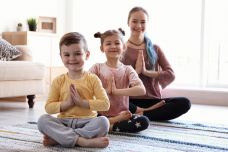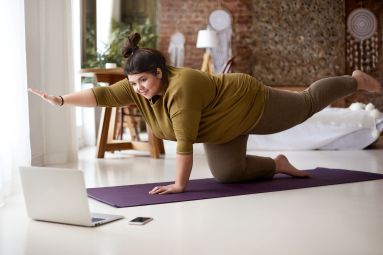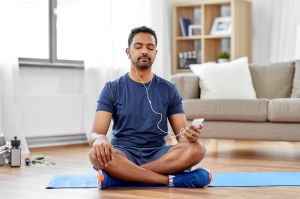Yoga At Home: An Approach to Maintaining Mental Health
Author: Dr. Alexandria Salerno
Let me first begin this post with hopeful wishes that you and your families are faring well during the current global state we are experiencing together. These days and weeks have been filled with plenty of uncertainty and fear, which can be uncomfortable to sit with for long periods of time. The intention behind this post is to offer a physical and mental approach to maintaining your mental health while in your home and perhaps ease some discomfort in these uncertain times.
As many sources continue to provide us with suggestions about how to cope with the current “stay-at-home” orders, physical movement of any kind will be of great importance. One physical and mental practice that can be especially helpful in these times is yoga.
Yoga and Its Many Benefits
Yoga is a specific method of moving the body while also asking our minds to slow down, turn inward, and be in the present moment. It is considered to be a physical practice of mindfulness. Although there are a wide range of yoga practices, the most common type practiced in the United States is Hatha. Hatha includes physical poses (asanas), coordinated and controlled breathing, as well as a period of deep relaxation or meditation. Research provides evidence that yoga practices of any type can reduce the impact of stress and may be helpful for anxiety and depression (1). Yoga has also been found to increase body awareness, reduce muscle tension, strain, and inflammation, and may calm the nervous system (involved in the stress response) (2).

Other benefits of yoga include:
- Increase of flexibility
- Improvement in circulatory and cardio health
- Improvement in sleep
- Increase of energy levels
- Aiding ease of chronic pain
- Release of endorphins, which may help to improve mood
Yoga is available to everyone and every body-type because each pose offers variations to make them accessible to the practicing individual. It will be important to assess your level of abilities before choosing a style of yoga to practice, but regardless, there is a practice available for you!
Making Space for Yoga
As it goes for most hobbies or personal interests, a central component to a beginning or continuing at-home yoga practice is to create a space that feels welcoming for you. If available, this may mean finding a spare room or an area in your home where you will be able to move freely with minimal disruptions. This might be challenging, given that many of us are sharing communal space with our families more than is typical, but try and find a place that could be dedicated to yourself for a set aside time.
You might also want to find ways of making the space your own- finding candles, lamps, plants, and other décor that feel relaxing. However you choose to make your space, be sure it feels comfortable for you and your practice!
Styles of Yoga to Consider for Your At-Home Practice
There are many different branches and styles of yoga, but here are a few types to consider while exploring this new method of mindfully moving at home:

Hatha – One of the more common forms of yoga; a gentle, slow practice, which can be great for beginners or those who prefer a more relaxed style of yoga or movement.
Vinyasa – Another common style of yoga practiced in the U.S.; more vigorous than Hatha and involves a quicker-paced flow continuously moving from one pose to another while coordinating breath with each pose.
Yin – A slow-paced style where poses are held for longer durations (five minutes or longer); a passive style that helps through deep stretches while increasing circulation in the joints and improving flexibility.
Restorative – Typically more of a gentle, slow, and relaxing style of yoga; poses will generally be held for 10 minutes or longer and involve a wide range of props to assist in the holding of each posture. Restorative yoga is less physically demanding and allows more space for rest.
Where to Access Yoga Classes from Home
Nowadays, yoga and other exercise videos are easily accessible on the internet. YouTube and other video streaming sites will likely have an abundance of yoga video resources. You may also consider reaching out to your local yoga studios and to see if they offer livestream or virtual (pre-recorded) classes you can access through their studio directly. Websites like Do Yoga with Me (3) offer plenty of resources and free yoga classes and YouTube offers a playlist that includes a compilation of yoga practices geared specifically towards “times of uncertainty” (4). Take time to explore the different styles of yoga and the varying classes and videos offered online!
While we wait for decisions to be made and questions to be answered, please pay mind to your physical and mental health in the process. Both will benefit from movement. Yoga is a mindful, accessible, and grounding physical practice that may provide positive effects for the mind and body.
If you are in need of additional support during this difficult time, Shared Vision is fully operational with telehealth services. Please complete an online submission today to connect with one of our clinicians.
Resources:
1. https://www.health.harvard.edu/mind-and-mood/yoga-for-anxiety-and-depression
2. https://www.psychologytoday.com/us/blog/get-hardy/201305/take-stand-yoga-today
3. https://www.doyogawithme.com/
4. https://www.youtube.com/playlist?list=PLui6Eyny-Uzy-b0MKzL2EfaTqB0ppgK06





